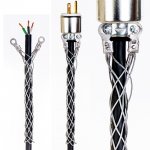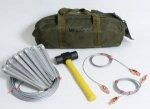No. Simply no. If you do not ground the trailer, you become the ground when you walk over to do something to it. I know people who have not just gone to the hospital for getting shocked by a trailer mounted gen set, but have had to be medically retired due to the damage the shock caused their body. The Army kills at least 2 people a yer, due to no ground/improper grounding of trailer mounted gen sets.
The issue of Touch Potential cannot be resolved by Grounding a Generator. That can only be done by installing an equipotential plane under and around the Generator or the vehicle on which it is mounted and bonded to. That is not a practical thing to do in mobile applications. It is only done in Electrical utility sub stations and in animal barn floors and entry/exit pathways to prevent the loss of livestock to step potential shock or electrocution.
Again I refer to the applicable language of the US National Electric Code.
"Electrical System Grounding. Electrical systems that are grounded shall be connected to earth in a manner that will limit the voltage imposed by lightning, line surges, or unintentional contact with higher-voltage lines and that will stabilize the voltage to earth during normal operation."
Notice that there is no mention of the prevention of electric shock or electrocution in that language. That is because connecting a conductive surface to earth is insufficient to lower the touch potential from a fault between that surface and an energized conductor to prevent injury. Their are 2 common misconceptions being stated here. Electrical current does not flow only on "the path of least resistance!" It flows on all the available pathways in direct proportion to their resistance. Understand that the path of least resistance may only be a single ohm different than the next most conductive pathway available. The current will divide into all of the conductive pathways present. That is one of the reasons that the NEC forbids the use of the earth as an Equipment Grounding Conductor (EGC).
" One or more grounding electrodes shall be permitted to be connected to the equipment grounding conductors specified in 250.118 and shall not be required to comply with the electrode bonding requirements of 250.50 or 250.53(C) or the resistance requirements of 250.53(A)(2) Exception, but the earth shall not be used as an effective ground-fault current path as specified in 250.4(A)(5) and 250.4(B)(4)."
This prohibition is meant to prevent exactly what some are arguing for in this thread. Depending on a connection to earth to clear a fault between a normally energized part of the generator and a non current carrying part simply doesn't work. Since the current flowing to ground is usually not enough to cause the Over Current Protective Device (OCPD) to open; which pending repair is the only way to clear or eliminate the fault; there will often be more than enough voltage between the fault and Ground to cause the 30 milliamperes that will kill a human being to flow. Grounding alone does not work. That is because of the second misconception being expressed as gospel here. Electrical current is not returning to earth. [See the purpose of Grounding above.] It is returning to it's source. In the use we are talking about here that source is the windings of the generator. A ground connection is a very unreliable way to do that. For it to function in that roll there would have to be a Grounding Electrode at the location of the fault and at the source and the sum of the impedance to earth would have to be less than 8 Ohms to permit more than the fifteen ampere trip point of the lowest rated OCPD to flow. An extremely good low impedance ground connection, such as the ones installed at remote communications equipment shelters and computer data server centers, is one with a impedance to ground of 10 Ohms or less. If the sum of the resistance at the fault point and the source of supply is over 8 ohms the 16 to 20 amperes needed to cause the OCPD to trip open and clear the fault WILL NOT FLOW! A single driven rod will never have that low an impedance unless it is thrown into salt water or driven into salt water saturated marsh or beach sand.
I know what I'm saying from personal experience. In addition to having worked in the electrical craft for my bread work I served as a volunteer firefighter for 45 years. At one point during the salvage and overhaul part of a suppression effort I was bringing a preconnected flood light to the work area. The shell of the flood light was made of Aluminum to reduce it's weight when handling it. The Apparatus Engineer; read equipment operator / driver; of the Lighting Unit was feeding the cord to me as I carried the flood light toward that site. I suddenly experienced a painful shock that caused all the muscles in my hand and arm to contract violently. Fortunately that caused my grip on the non conductive phenolic plastic (Bakelite) handle to tighten which removed my hand from contact with the metal shell of the flood light. This was at the end of operations on a 4th alarm fire. Everyone's protective clothing was soaked with water to the point that the clothing was somewhat conductive for short distances, such as through my glove to my hand. Now what caused me to get a shock from a vehicle mounted generator? There has to be a complete pathway from the source of the current through a load and back to the source for current to flow. That lighting unit had been obtained as surplus equipment from the Office of Civil Defense. All of the cords provided with it and fitted to it's multiple cord reels were 2 wire. One energized, or hot, conductor and one Grounded Current Carrying Conductor, which we all call a neutral even when it's not. There was no equipment grounding conductor in the cords. Because the cords were not fitted with cord grips

my puling on the cord by the flanged inlet plug mounted in the flood light caused a fault to the aluminum shell of the flood light. Where then was the other side of the circuit? Since it has only been realized over the last several decades that grounding does not provide safety for touch potential injury the instructions on the surplus lighting unit included extending a reel mounted GEC to a grounding electrode. Since this was a fire department vehicle the obvious grounding electrode was the underground metal water piping that supplied the fire hydrants. The large alligator clamp on the end of what was made to be the static bonding line of fuel truck was clipped to the bolted flange at the base of the hydrant barrel which is bolted to the flange at the end of the hydrant riser. Perhaps lucky for me no one ever stops to remove the paint from the hydrant contact surface nor to twist the alligator clamp back and forth until it scrapes through the paint. That said the paint used is at least slightly conductive. The shock pathway was through the energized conductor of the cord, to the aluminum shell of the flood light, through my badly contaminated and water soaked protective clothing, into the earth, through the 24 inch water mains, through the grounding cable of the lighting unit, and back to the source in the windings of the generator. A highly contributing factor in the length of the shock was that the breaker which was the OCPD of the cord reel I was using did not open because although plenty of current was flowing to hurt like hell come to breakfast not enough current was flowing to open the OCPD.




